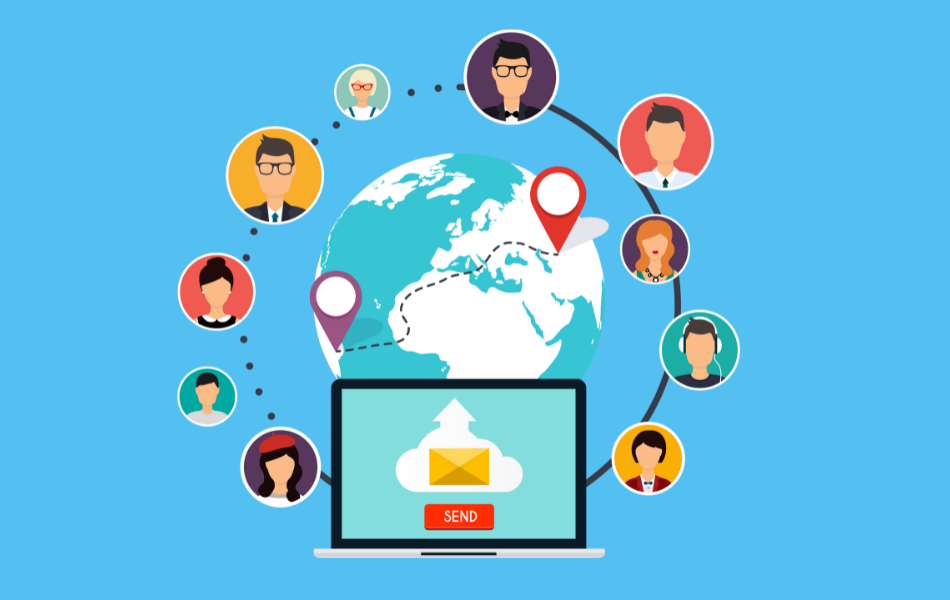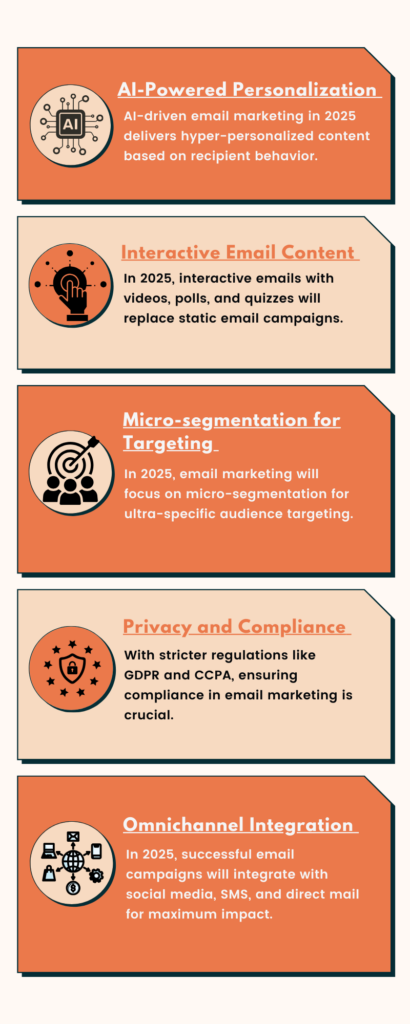
Why Direct Email Marketing Is the Key to Healthcare Marketing Success in 2025
For B2B healthcare marketers, the inbox remains the most valuable channel for connecting with decision-makers. As we enter 2025, direct email marketing continues proving its effectiveness as a cost-effective marketing channel, delivering measurable results and enabling targeted outreach to potential customers in the healthcare industry.
However, the digital landscape is evolving rapidly. Crowded inboxes, rising expectations for personalized experiences, and stricter compliance regulations mean simply sending emails won’t suffice. To succeed, your email marketing campaigns must embrace trends like personalization, interactive content, and micro-segmentation.
In this guide, we’ll explore the email direct marketing trends, strategies, and tools that will define success for healthcare marketers in 2025.
Whether you’re targeting hospital administrators, specialists, or C-level executives, staying ahead of these trends will ensure your marketing efforts achieve maximum impact.
What Is Direct Email Marketing?
Direct email marketing is a strategy that involves using targeted emails to engage specific audiences, build relationships, and drive conversions. Unlike general email blasts, direct marketing by email relies on precise targeting, personalization, and relevant content to deliver value to recipients.
For B2B healthcare marketers, this means leveraging best email lists to connect with decision-makers like hospital administrators, physicians, or procurement managers, ensuring that every email delivers measurable results.
Why Direct Email Marketing Matters for Healthcare Marketers ?
Healthcare marketers face unique challenges, including navigating complex decision-making processes, ensuring compliance with privacy regulations, and reaching diverse audiences. Direct email marketing addresses these challenges by providing:
- Precision Targeting: With verified email lists, you can focus your outreach on specific segments, such as hospital CEOs or cardiology specialists.
- Cost-Effectiveness: Email remains one of the most affordable and impactful B2B marketing channels, offering high ROI compared to other digital strategies.
- Measurable Results: Email campaigns provide clear metrics to evaluate performance and optimize for better results, from open rates to click-through rates.
- Relationship Building: Personalized, value-driven emails help build trust and foster long-term engagement with your audience.
Top Trends in Direct Email Marketing for 2025

AI-Powered Personalization
Personalization has always been a hallmark of effective email direct marketing, but 2025 takes it to a new level with AI. Advanced analytics and machine learning allow marketers to deliver hyper-personalized content that adapts dynamically to recipient behaviour.
- How It Works: AI analyzes recipient data to craft tailored marketing messages, optimize subject lines, and automate follow-ups.
- Why It Matters: Campaigns using AI-driven personalization achieve up to 30% higher click-through rates and stronger engagement.
Interactive Email Content
Static emails are a thing of the past. In 2025, direct email marketing campaigns incorporating interactive elements—such as videos, polls, and quizzes—will dominate.
- Benefits: Interactive content increases engagement, with average conversion rates improving by 20%.
- Example: A pharmaceutical company could embed a video demo of their new product directly in the email, making it more engaging for healthcare professionals.
Micro-segmentation for Targeting
In 2025, direct marketing by email will focus on micro-segmentation, allowing marketers to break their audiences into ultra-specific groups for better relevance.
- How It Works: Advanced segmentation can be used to target recipients based on factors such as specialty, geographic location, or purchase behavior.
- Example: Target oncologists in urban hospitals with data-driven emails about the latest cancer treatments.
Privacy and Compliance
As regulations like GDPR and CCPA become stricter, ensuring compliance in email marketing campaigns is more important than ever.
- Best Practices: Use permission-based email lists, include clear opt-out options, and ensure all communications meet privacy standards.
- Impact: Compliance protects your reputation and builds trust with recipients, improving engagement and reducing spam complaints.
Omnichannel Integration
Email works best when integrated with other channels like social media, SMS, and direct mail. In 2025, successful campaigns will align email with broader marketing strategies for maximum impact.
- Example: Follow up an email about a new product launch with a targeted LinkedIn message or SMS reminder.
- Why It Works: Omnichannel campaigns provide a seamless experience, reinforcing your marketing message across touchpoints.
Metrics to Track for Email Marketing Success
To optimize your email marketing efforts, monitor these key metrics:
- Open Rate: Indicates the effectiveness of your subject lines and email timing.
- Click-Through Rate (CTR): Reflects how well your content and call to action engage recipients.
- Conversion Rate: Tracks the percentage of recipients who take desired actions, such as signing up for a free trial or downloading a whitepaper.
- Bounce Rate: A high bounce rate may signal outdated data—ensure your email lists are up-to-date and accurate.
- Spam Complaints: Monitor complaints to improve deliverability and avoid penalties.
Best Practices for Direct Email Marketing in 2025
To ensure your direct email marketing campaigns deliver results, follow these best practices:
Deliver Value in Every Email
Ensure your emails provide actionable insights, industry updates, or practical solutions. This method establishes your brand as a trusted resource.
Write Compelling Subject Lines
A strong subject line is essential for capturing attention. Test different variations to determine what resonates with your audience.
Include Clear Calls to Action
Guide recipients toward specific actions with clear and prominent CTAs, whether “Request a Demo” or “Download Now.”
Keep Your Email Lists Updated
Regularly update your email lists to maintain accuracy, reduce bounce rates, and improve engagement.
Test and Optimize
Use A/B testing to evaluate elements like subject lines, content layout, and CTAs. Based on performance data, continuously refine your campaigns.
Conclusion: Transform Your Email Marketing Strategy in 2025
For B2B healthcare marketers, 2025 is a year of transformation for direct email marketing. By leveraging healthcare marketing trends like AI-driven personalization, interactive content, and micro-segmentation, you can elevate your campaigns and achieve measurable success.
Partnering with MedicoLeads ensures your email lists are accurate, segmented, and compliant. With the right tools and strategies, you can turn your email marketing campaigns into powerful drivers of awareness, engagement, and conversions.
Ready to take your campaigns to the next level?
Embrace the future of direct email marketing and make 2025 your most impactful year yet.
FAQ's
What is direct email marketing?
Direct email marketing is a strategy that uses targeted emails to engage specific audiences, build relationships, and drive conversions.
How can I enhance my email open rates?
Craft compelling subject lines, segment your audience for relevance, and optimize your send times.
Why is personalization important in email marketing?
Personalization improves engagement by delivering content tailored to the recipient’s preferences and needs.
How do I ensure compliance in email marketing?
Use permission-based email lists, adhere to GDPR, CCPA and CAN-SPAM regulations, and provide clear opt-out options.
What is direct email marketing, and how does it work?
Direct email marketing involves sending targeted, personalized emails to specific audiences to promote products, build relationships, and drive conversions. It uses segmented email lists to deliver relevant content, ensuring higher engagement and measurable results through metrics like open and click-through rates. This strategy is especially effective in B2B sectors like healthcare, where precision targeting is critical.
Why is direct email marketing important for B2B businesses?
Direct email marketing allows B2B businesses to reach decision-makers with personalized, actionable content. It is a cost-effective marketing channel that offers measurable ROI, enables precise targeting, and builds trust through tailored messaging. For industries like healthcare, it’s indispensable for connecting with niche audiences such as hospital administrators or specialists.
What are the best practices for creating a successful direct email marketing campaign?
Successful direct email marketing campaigns rely on personalization, clear call-to-action messages, and audience segmentation for relevance. Craft compelling subject lines to boost open rates and ensure your email list is updated to maintain accuracy. Regular testing and optimization using A/B testing also help refine strategies and improve performance.
How can personalization improve the effectiveness of direct email marketing?
Personalization makes recipients feel valued, leading to higher open rates, increased click-through rates, and better conversion rates. Marketers build trust and strengthen relationships by tailoring content to recipients’ preferences, roles, or past interactions. Advanced tools like AI can take personalization further by adapting emails dynamically based on user behavior.
What metrics should you track to measure the success of direct email marketing?
Key metrics include:
- Open rates (to assess subject line performance).
- Click-through rates (to measure engagement).
- Conversion rates (to track completed actions).
Monitoring bounce rates ensure your email list is accurate, while keeping an eye on spam complaints safeguards deliverability and compliance with regulations.






